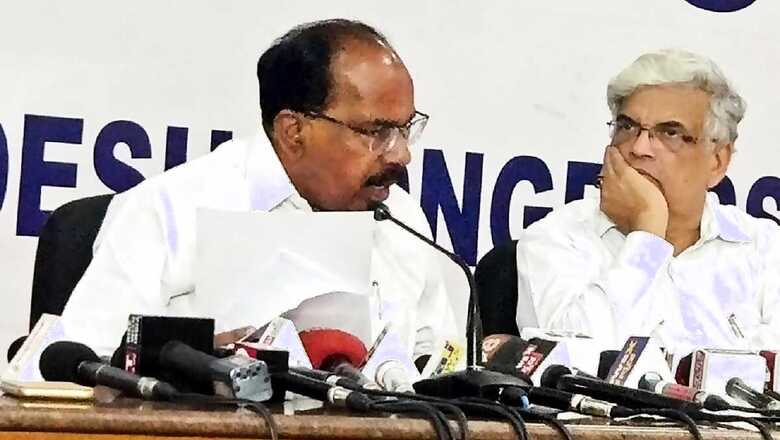
views
Gross criminal neglect of not building planned strategic oil reserves led to India losing its greatest opportunity to build strategic stockpile using multi-year low global oil prices, former petroleum minister M Veerappa Moily alleged on Saturday while questioning the move to hire a US facility for the purpose.
In a statement, Moily said 5.33 million tonnes of strategic oil storages were built by the Congress-led UPA-I and II at Visakhapatnam in Andhra Pradesh, Mangalore and Padur (both in Karnataka) to support almost 10 days of India's oil needs during an emergency.
Plans for another 12.5 million tonnes of strategic storage in four states was initiated by the UPA-II in 2013 but these were put on back burner by the BJP-led NDA government, he alleged. Had these reserves being built in the past six years, India could have stored oil in them by buying it when international rates plunged to two-decade low in April. Instead the government is now looking to hire US strategic storages to augment India's emergency stockpile.
"The said partnership to store crude oil in the Strategic Petroleum Reserve of the US is not diplomatically and strategically advisable as reported from the agreement drawn between India and the US under the Strategic Energy Partnership (SEP) ministerial meet, co-chaired by Petroleum Minister Dharmendra Pradhan and US Energy Secretary Dan Brouillette. "It is in the best interest of oil security of the country that we pursue building additional capacity as was proposed by UPA-2," he said.
Instead of paying the US, it was better to build storage in their own country. Besides, accessing oil stored in US facilities would be difficult if sea routes were blocked. Strategic storages are built as insurance against supply disruptions.
"Even after six years there has been a gross criminal neglect on the part of the present government either to put up new refineries or set up more strategic storage facilities in the public sector or even in the private sector. "The NDA government has lost the greatest opportunity of storing strategic reserves which is now available at the lowest international prices. The laxity on the part of the NDA to preserve the integrity of oil reserves is a national tragedy," he said.
Moily said the UPA had invested USD 600 million in building strategic storage capacity at Visakhapatnam (1.33 MMT), Mangaluru (1.5 MMT) and Padur (2.5 MMT). "Taking into account the oil security concerns of India, the UPA-II in 2013 had decided to augment the strategic crude oil storage in the country and planned for an additional crude oil storage facility and entrusted Indian Strategic Petroleum Reserves Ltd (ISPRL) with the responsibility of preparation of Detailed Feasibility Reports (DFRs) for 12.5 million tonnes of strategic storage of crude oil in Phase-II in four States," he said.
The locations chosen were Bikaner in Rajasthan, Chandikhol in Odisha, Rajkot in Gujarat and Padur-II in Karnataka. The DFRs had been prepared by Engineers India Ltd (EIL) with capacities proposed as Chandikhol 3.75 MMT, Rajkot 2.5 MMT, Bikaner 3.75 MMT and Padur 2.5 MMT. But these were never pursued by the BJP-led NDA government in the last six years.
"It now appears that the NDA government has just woken up to the reality and planned to take forward the UPA for an additional 6.5 million tonnes storage at Chandikhol (4 MMT) in Odisha and Padur (2.5 MMT) in Karnataka," he said. The planned second phase with an investment of USD 1.6 billion will add another 12 days of crude storage once operational and will take the total storage capacity to 87 days after adding the 65 days of storage capacity with the country's refiners.
"The DFRs prepared by Engineers India Ltd (EIL) had been put to cold storage by the present regime," he alleged. India's current refining capacity stands at 249 million tonnes per annum, comprising of its 23 refineries – 18 under public sector, three under private sector and two in joint ventures.
Indian Oil Corporation (IOC) is the largest domestic refiner with a capacity of 80.7 MMTPA. Top three companies IOC, Bharat Petroleum Corporation (BPCL) and Reliance Industries (RIL) – contribute around 66.7 per cent of India's total refining production in FY 2018-19. "The UPA I and UPA II had also taken effective steps to double the refining capacity of Paradip refinery and also to increase the refining capacity at Mangalore, Cochin refinery and other refineries in the country," he said.
A Rs 42,000 crore Barmer refinery-cum-petrochemical complex in Rajasthan was initiated in 2013 to take advantage of the crude availability in the region and to generate employment opportunities to the locals, he said. "The project was abolished by the NDA government. It is only recently that they have planned to revive the project. The NDA government neither took forward the UPA agenda nor did they introduce any new capacity in the refinery," he added.


















Comments
0 comment